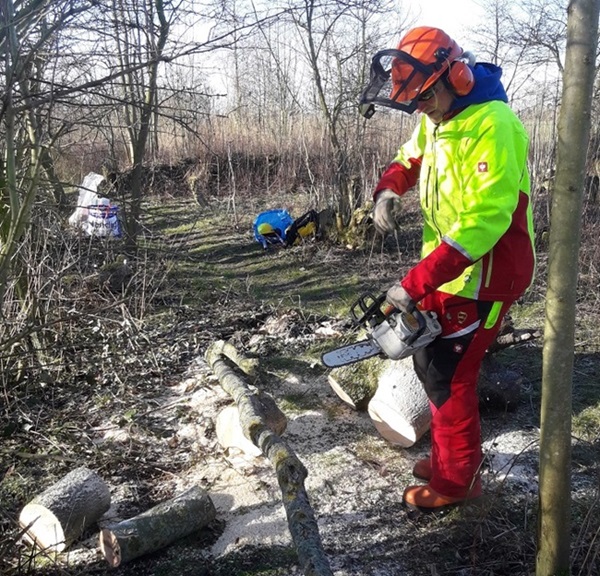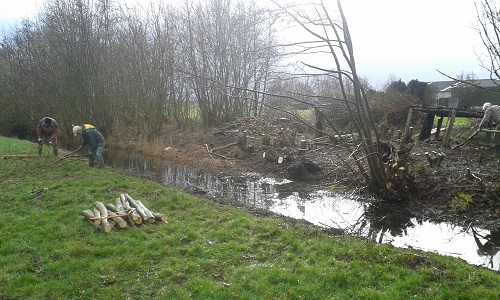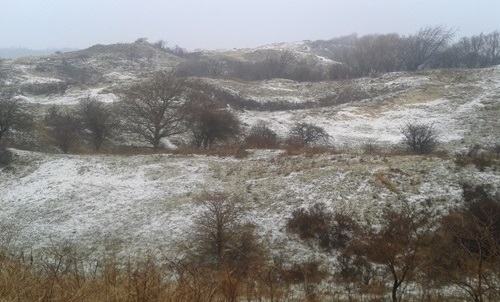
I always used to translate Dutch into English, as that is what I am MITI-qualified to do. However, it seems that in recent years many into-Dutch translators have retired. Consequently one of my customers now regularly asks me to translate into Dutch – mostly operating manuals for mowers, chainsaws and other equipment used in the groene sector, the land-based trades, i.e. forestry, horticulture, groundskeeping, etc. As a conservation volunteer, I get to operate some of this equipment, chat with farmers and grounds personnel, and work with other volunteers from a wide range of backgrounds. As a result, my work and volunteering tend to support each other, making me more effective in both roles, and making both more enjoyable.
 A number of years ago I joined an NLdoet volunteer work session in a park close to where I live in The Hague. I enjoyed that, so through a volunteering website I found the Werkgroep Agrarisch Natuurbeheer (WAN), which is active around Wassenaar and Leiden. The group manages geriefbosjes, coppices that used to supply farms with wood. Coppicing means regularly cutting trees back to stumps, after which they regenerate very quickly. This is done in winter when the trees are dormant. We mostly use an eight-year rotation, after which time the new shoots on the trees (ash, hazel, etc.) have grown to a height of six to eight metres and a diameter of around ten centimetres. It is essentially the same as pollarding where trees are cut higher up – knotwilgen being a key example in the Netherlands. Historically, coppiced timber was an important resource for the farms, providing both firewood and wood for tool handles, etc. However, as coppicing is very labour-intensive farmers have stopped doing it. Because copses can be an important habitat for a range of species, some are now looked after by voluntary groups such as WAN. We not only coppice and pollard trees but also plant new trees, dredge ditches, help install nest cameras, etc. Most of the work is done using pruning saws (pistoolzagen) which cut very quickly. We occasionally use chainsaws for heavier work and crosscutting the felled timber.
A number of years ago I joined an NLdoet volunteer work session in a park close to where I live in The Hague. I enjoyed that, so through a volunteering website I found the Werkgroep Agrarisch Natuurbeheer (WAN), which is active around Wassenaar and Leiden. The group manages geriefbosjes, coppices that used to supply farms with wood. Coppicing means regularly cutting trees back to stumps, after which they regenerate very quickly. This is done in winter when the trees are dormant. We mostly use an eight-year rotation, after which time the new shoots on the trees (ash, hazel, etc.) have grown to a height of six to eight metres and a diameter of around ten centimetres. It is essentially the same as pollarding where trees are cut higher up – knotwilgen being a key example in the Netherlands. Historically, coppiced timber was an important resource for the farms, providing both firewood and wood for tool handles, etc. However, as coppicing is very labour-intensive farmers have stopped doing it. Because copses can be an important habitat for a range of species, some are now looked after by voluntary groups such as WAN. We not only coppice and pollard trees but also plant new trees, dredge ditches, help install nest cameras, etc. Most of the work is done using pruning saws (pistoolzagen) which cut very quickly. We occasionally use chainsaws for heavier work and crosscutting the felled timber.
A few years ago I had to translate some chainsaw manuals so that was a good opportunity to do a course at IPC Groene Ruimte, a vocational training centre. Just as important as gaining technical knowledge and experience was chatting with the groene sector workers – basically the people who read the manuals I translate. Later, I also did courses on brush cutters and other equipment.
As the copses where I work are nearby farms, I get to chat with the farmers and learn about their work and equipment. That has been very useful in translating manuals for milking robots, tractors and flail mowers.
 I also do some volunteering for Dunea, the drinking water company, which serves around 1.3 million customers in the west of Zuid-Holland and manages around 2,500 hectares of dunes that form part of the Nationaal Park Hollandse Duinen. Most of that work involves removing invasive vegetation such as black cherry (Amerikaanse Vogelkers) and white poplar (abeel) to preserve the openness of the dune landscape. These trees have to be dug out completely – cutting them would only cause them to grow back, as in coppicing. Again, chatting with Dunea staff and the other volunteers during coffee breaks can be very informative.
I also do some volunteering for Dunea, the drinking water company, which serves around 1.3 million customers in the west of Zuid-Holland and manages around 2,500 hectares of dunes that form part of the Nationaal Park Hollandse Duinen. Most of that work involves removing invasive vegetation such as black cherry (Amerikaanse Vogelkers) and white poplar (abeel) to preserve the openness of the dune landscape. These trees have to be dug out completely – cutting them would only cause them to grow back, as in coppicing. Again, chatting with Dunea staff and the other volunteers during coffee breaks can be very informative.
For me, combining conservation volunteering with working in areas such as agriculture and horticulture works really well.
|
Blog post by: Hans van Bemmelen Website: www.techtrans.eu LinkedIn: hans-van-bemmelen |
